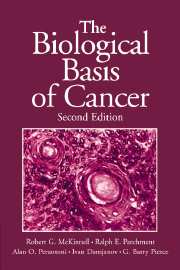Book contents
- Frontmatter
- Contents
- Preface
- Introduction: Letters illustrating clinical aspects of cancer
- 1 The pathology of cancer
- 2 Invasion and metastasis
- 3 Carcinogenesis
- 4 Genetics and heredity
- 5 Cancer-associated genes
- 6 Cancer in nonhuman organisms
- 7 Epidemiology
- 8 Lifestyle: Is there anything more important?
- 9 The stem cell basis of cancer treatment: concepts and clinical outcomes
- 10 Oncology: The difficult task of eradicating caricatures of normal tissue renewal in the human patient
- Appendix: Description of selected tumors
- Glossary
- References
- Index
- Plate section
9 - The stem cell basis of cancer treatment: concepts and clinical outcomes
Published online by Cambridge University Press: 05 June 2012
- Frontmatter
- Contents
- Preface
- Introduction: Letters illustrating clinical aspects of cancer
- 1 The pathology of cancer
- 2 Invasion and metastasis
- 3 Carcinogenesis
- 4 Genetics and heredity
- 5 Cancer-associated genes
- 6 Cancer in nonhuman organisms
- 7 Epidemiology
- 8 Lifestyle: Is there anything more important?
- 9 The stem cell basis of cancer treatment: concepts and clinical outcomes
- 10 Oncology: The difficult task of eradicating caricatures of normal tissue renewal in the human patient
- Appendix: Description of selected tumors
- Glossary
- References
- Index
- Plate section
Summary
Introduction
Notwithstanding physical removal of malignant tumors by surgery and regional control of malignant tumors by radiation, the concept of cancer as a disease of abnormal stem cell biology leads to three philosophies for treating the disseminated, metastatic disease that most patients will face. Only one of these philosophies has become clinically useful, whereas the others are developing or remain at the conceptual level.
Therapies remaining at the conceptual level
One treatment to attack this caricature of normal renewing biological tissue is conversion, or perhaps reversion, of the malignant phenotype to a benign state. As studies of the fate of micro-injected cancer cells in the embryo have revealed (detailed in Section 1.15, Chapter 1), it is possible for malignant cells to lose their malignant potential without losing their proliferative potential, such that they contribute to normal formation of chimeric organs in the developing embryo. The development of chimeras containing some functional tissue derived from the implanted malignant cells indicates that the cancer cells reacquire the capacity to properly respond to biological controls on tissue renewal even into adulthood after the embryonic environment disappears. The concept is that once converted back to normalcy by these embryonic control mechanisms, wherein the malignant phenotype is removed or suppressed, cancer-derived normal cells in the adult chimera can no longer cause disease. Therapeutic strategies harnessing this biological control might not be toxic in the adult patient, because they would target malignant, embryonic-like stem cells, converting them into normally functioning adult stem cells.
- Type
- Chapter
- Information
- The Biological Basis of Cancer , pp. 266 - 306Publisher: Cambridge University PressPrint publication year: 2006

